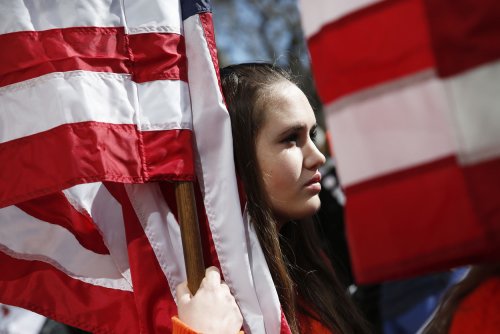A trader signals in the Eurodollar futures pit on the trading floor at the CME Group on September 21, 2011 in Chicago. The Federal Reserve Open Market Committee announced Wednesday that it would keep a key short term interest rate at the historically low rate of zero to 0.25 percent. In its policy statement, the Fed announced it will be selling $400 billion worth of short-term securities and buying and equal amount of longer-term securities in a move to push long term interest rates lower. UPI/Brian Kersey |
License Photo
The Federal Reserve voiced an odd sentiment Tuesday, but one that has been building steam: The U.S. economy is making moderate gains.
"The committee continues to expect a moderate pace of economic growth over coming quarters and consequently anticipates that the unemployment rate will decline only gradually," the Fed's Open Market Committee said in a statement.
The bank also pointed to Europe's ongoing debt troubles. "Strains in global financial markets continue to pose significant downside risks to the economic outlook," the statement said.
Meanwhile, the FOMC elected to keep its monetary policies intact. That entails keeping the federal fund rate at zero to 0.25 percent, maintaining the size of its securities portfolio, currently at about 2.5 trillion, and exchanging a sizable portion of its short-term bonds with long-term bonds to convince businesses that low interest rates on loans are here to stay, at least for the foreseeable future.
Paradoxically, that note of confidence sent stocks down Tuesday afternoon, as investors were counting on a boost from the Fed that did not come.
The economy, however, looks just as it did a year ago, a New York Times reporter astutely pointed out. The economy looked to be turning around January through April of 2011. It could be another seasonal spring upswing is around the corner.
There are those who quickly point to the enormous U.S. deficit and the debt crisis in Europe and not very indelicately declare that the day will come when the United States also has to pay the fiddler. Europe, for all the pain it is going through now, may just be ahead of the curve and when the U.S. economy turns on its heels the way Europe is now, it is not going to be pretty.
The bottom line, however, is doing good business. The United States must earn its keep, just like anybody else. If it does, all bets are off.
But that isn't happening. The U.S. trade deficit is all the proof required that the economy needs more than a moderate run at a recovery to avoid big trouble.
The trade deficit runs at about $45 billion a month with much of that outlay going to China and the Organization of Petroleum Exporting Countries.
On an annual basis, that half a trillion dollars is a sizable hole in the U.S. budget. While a deficit with China makes some frustrating sense, in October the United States, inexplicably, was $2.8 billion behind in trades with Ireland and $5.3 billion behind in trades with Mexico. Not to sound hysterical, but the chief executive officer of a company the size of the United States who let trade with a company the size of Ireland fall into the red would be out the door before lunch. Maybe earlier.
As it happens, however, the issue on the table for now is confidence. In that category, the United States has been given, at least temporarily, a green light. On Aug. 5, the Friday before credit rating agency Standard & Poor's downgraded the U.S. credit rating from triple A to AA+, yields on 10-year treasury notes stood at 2.565 percent. On Wednesday morning, the yield on 10-year notes was 1.967 percent.
In some regards, fear in Europe is giving U.S. bonds a boost, not because U.S. bonds are safe, but because they are relatively safe. In Italy, for example, yields of five-year bonds hit 6.47 percent Tuesday, a jump up from November, when yields were at 6.30 percent.
In international markets Wednesday, the Nikkei 225 index in Japan dropped 0.39 percent, while the Shanghai composite index in China lost 0.89 percent. The Hang Seng index in Hong Kong slipped 05 percent, while the Sensex in India gave up 0.76 percent.
The S&P/ASX 200 index in Australia was flat, off 0.07 percent.
In midday trading in Europe, the FTSE 100 index shed 1.1 percent, while the DAX 30 in Germany lost 1.14 percent. The CAC 40 in France lost 1.74 percent, while the Stoxx Europe 600 lost 0.95 percent.















